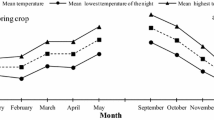Abstract
The cortical and perimedullary cells of the potato tuber increased in size when treated with the diethanolamine and the potassium salt of maleic hydrazide. The best time for maleic hydrazide application appeared to be from mid to late July. There was a greater increase in cell size in the cortex than the perimedullary region and treatment with the amine salt was more effective than the potassium salt. The cells were smallest at the bud end; however, with maleic hydrazide treatment, increase in cell size was greater in this region compared to the midsection and stem end. From late August to late September the cell size of untreated tubers remained relatively unchanged, whereas, tubers treated with the amine salt showed a 16 to 46% increase with a lesser increase with the potassium salt. The rounder form of the treated tubers can be explained by the shape and increase in cell size in the cortical and perimedullary region. Increase in cell size also may help prevent the formation of misshapen tubers.
Resumen
Las células corticales y perimedulares del tubérculo de papa aumentaron de tamaño cuando fueron tratados con las sales dietanolamina y potasio de hidracida maleica. El mejor momento de aplicacidn de hidracida maleica fué de mediados a fines de Julio. El incremento del tamaño de las celulas fué mayor en la región cortical que en la perimedular, siendo el tratamiento con dietanolamina más efectivo que la sal potásica. Las células mas pequeñas se produjeron en el extremo terminal del tuberculo; sin embargo, el tratamiento con hidracida maleica produjo un mayor incremento en el tamaño de las células de esa región en comparación a la seccidn central y la de unidn al tallo. Desde fines de Agosto a fines de Septiembre el tamaño de las células de los tubérculos no tratados permaneció constante, mientras que los tubérculos tratados con dietanolamina mostraron 16 a 46% de aumento. Este aumento fué menor en el tratamiento con la sal potásica. La forma redondeada de los tubérculos tratados pudo deberse a la forma y aumento en tamaño de las células en región cortical y perimedular. El incremento en el tamafño de las células podría también ayudar a prevenir la producción de tubdrculos deformados.
Similar content being viewed by others
Literature Cited
Abel-Rahman, M. and F.M.R. Isenberg. 1974. The role of exogenous growth regulators in the dormancy of onion bulbs. J Agric Sci 82:113–116.
Beach, R. and A.C. Leopold. 1953. The use of maleic hydrazide to break apical dominance ofChrysanthemum morifolium. Proc Am Soc Hortic Sci 61:543–549.
Compton, Winifred. 1952. The effects of maleic hydrazide on growth and cell division inPisum sativum. Bull Torrey Bot Club 79:205–211.
DeRivero, J.M. and J. Cornejo. 1969. Trials of preharvest; sprays with maleic hydrazide for sprout control of garlic. Bol Patal Veg Entomal Agric 31:71–77.
Gifford, E.M. 1956. Some anatomical and cytological responses of barley to maleic hydrazide. Am J Bot 43:72–80.
Greulach, Victor A. 1953. Notes on starch metabolism of plants treated with maleic hydrazide. Bot Gaz 114:480–481.
Greulach, V.A. and E. Atchison. 1953. Inhibition of mitosis in bean buds by maleic hydrazide. Bot Gaz 114:478.
Johansen, D.A. 1940. Plant Microtechnique. McGraw-Hill Book Company Inc., New York and London.
Klein, W.H. and A.C. Leopold. 1953. The effects of maleic hydrazide on flower initiation. Plant Physiol 28:293–298.
Nakashima, T. and T. Kinoshita. 1954. Change of the amount of starch treated with MH30, J Utilization of Agric Prod 1:202–203.
Paterson, D.R., S.H. Wittwer, L.E. Weller and H.M. Sell. 1952. The effect of preharvest foliar sprays of maleic hydrazide on sprout inhibition and storage quality of potatoes. Plant Physiol 27:135–142.
Peterson, E.L. 1952. Controlling tobacco sucker with maleic hydrazide. Agron J 44:332–333.
Reeve, R.M., H. Timm and M.L. Weaver. 1973. Parenchyma cell growth in potato tubers I. Different tuber regions. Am Potato J 50:49–57.
Salisbury, Frank. 1957. Growth regulators and flowering survey methods. Plant Physiol 32:600–608.
Sparks, W.E. 1958. Abnormalities in the potato due to water uptake and translocation. Am Potato J 35:430–436.
Struckmeyer, B. Esther. 1953. The effect of maleic hydrazide on the anatomical structure of Craft Easter Lilies. Am J Bot 40:25–29.
Weis, G.G., J.A. Schoenemann and M.D. Grosskopp. 1980. Influence of time of application of maleic hydrazide on the yield and quality of Russet Burbank potatoes. Am Potato J 57:197–204.
Author information
Authors and Affiliations
Additional information
This study was supported in part by the University of Wisconsin, College of Agricultural and Life Sciences, and the Wisconsin State Potato Industry Board.
Rights and permissions
About this article
Cite this article
Struckmeyer, B.E., Weis, G.G. & Schoenemann, J.A. Effect of two forms of maleic hydrazide on the cell structure at the midsection, stem and bud ends of the cortical and perimedullary regions of Russet Burbank tubers. American Potato Journal 58, 611–618 (1981). https://doi.org/10.1007/BF02853472
Received:
Issue Date:
DOI: https://doi.org/10.1007/BF02853472




